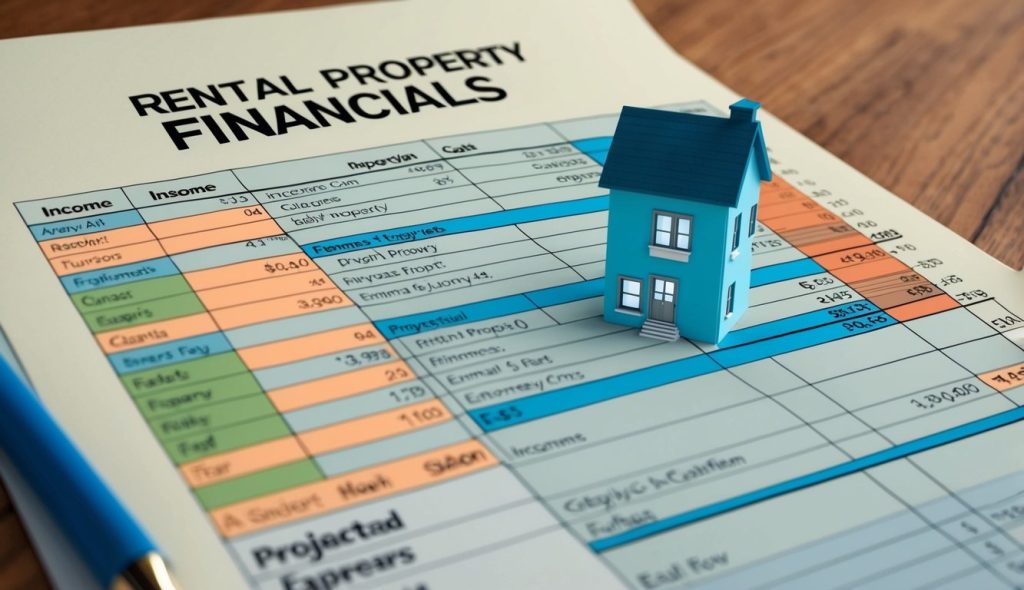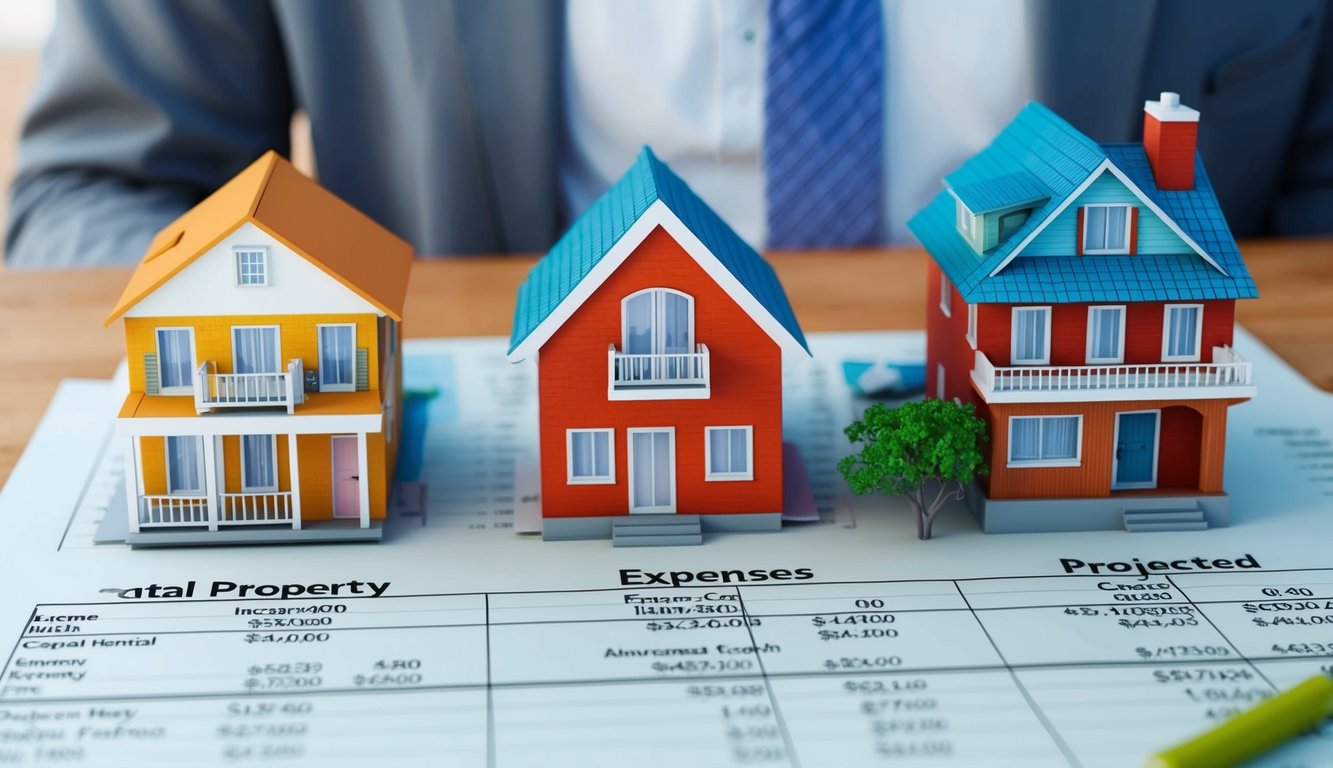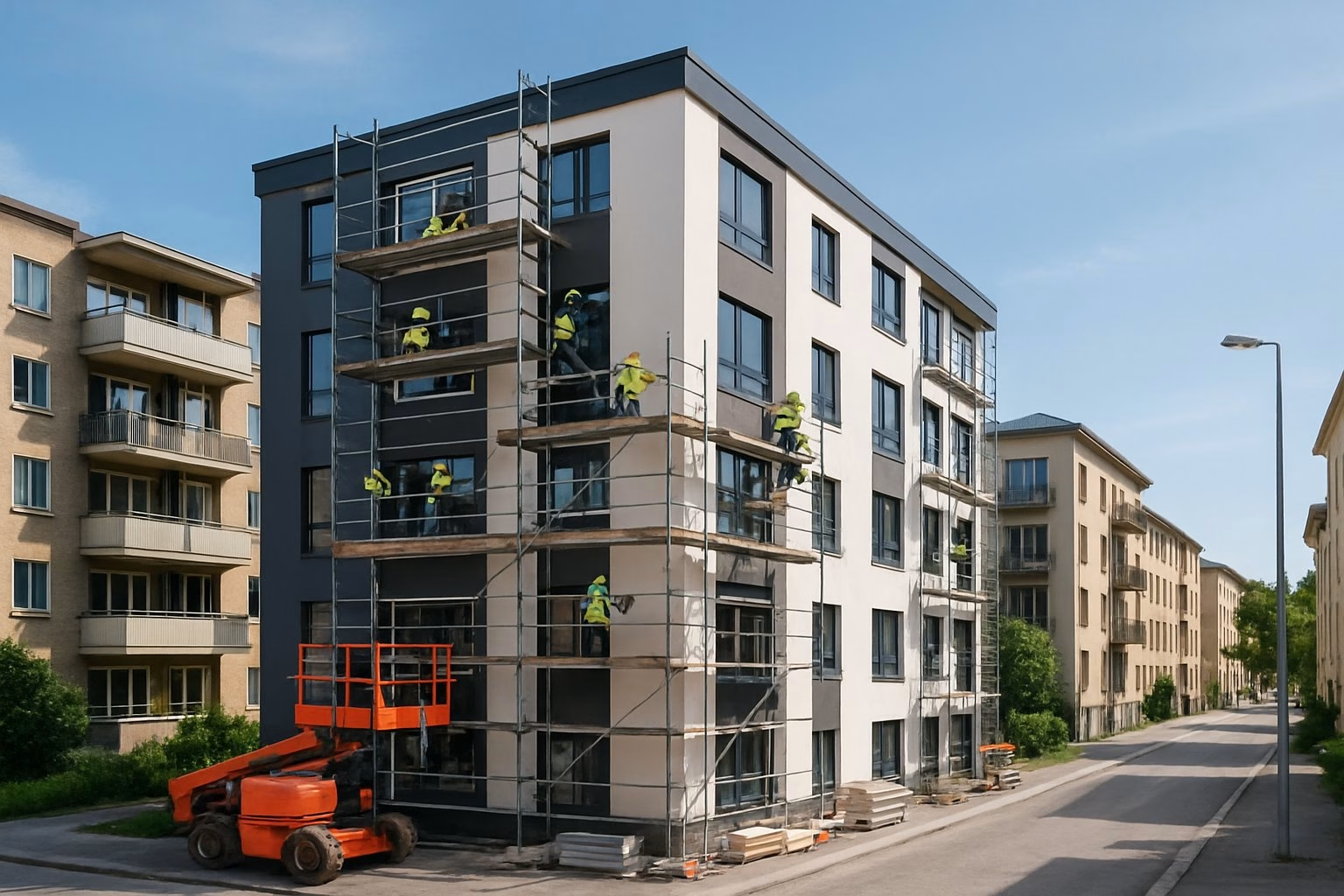Making smart investment decisions in real estate requires a clear understanding of potential returns. A rental property pro forma helps you analyze and project the financial performance of an investment property before making a purchase. A pro forma is a detailed financial projection that calculates expected income, expenses, and cash flow to determine if a rental property will be profitable.
Creating an accurate pro forma involves examining market rates, occupancy projections, and operating expenses. By calculating the net operating income (NOI) and cash flow projections, you can evaluate whether a property meets your investment criteria. This critical analysis helps you avoid costly mistakes and identify properties with the highest potential returns.
Key Takeaways
- Pro forma analysis predicts future property performance by evaluating income, expenses, and cash flow
- Accurate market data and realistic assumptions create reliable financial projections for investment decisions
- Regular pro forma review helps optimize property performance and maximize returns on investment
Fundamentals of Rental Property Financial Proforma
A rental property pro forma serves as your financial roadmap for evaluating potential real estate investments and projecting future performance. This essential tool helps determine investment viability through detailed income and expense analysis.
Purpose and Importance
Pro forma analysis enables you to make data-driven investment decisions by examining potential returns before purchasing a property. The financial projections help identify risks and opportunities early in the evaluation process.
Your pro forma calculations provide critical insights for securing financing, as lenders use these projections to assess loan risk and feasibility.
By creating detailed financial models, you can compare multiple investment opportunities and determine which properties align with your investment goals.
Key Terminology
Net Operating Income (NOI): Your property’s total revenue minus operating expenses, excluding debt service.
Cap Rate: The ratio of NOI to property value, expressed as a percentage to measure potential return.
Gross Rental Income: The total rental income if your property maintains 100% occupancy at market rates.
Vacancy Rate: The estimated percentage of time your rental units remain unoccupied.
Operating Expenses: Costs including:
- Property taxes
- Insurance
- Maintenance
- Utilities
- Property management fees
Common Financial Metrics
The real estate pro forma tracks several key performance indicators:
Cash Flow: Your NOI minus debt service payments and capital expenditures.
Return on Investment (ROI): The percentage return calculated by dividing annual cash flow by total investment.
Debt Service Coverage Ratio: NOI divided by annual mortgage payments, indicating your ability to cover loan obligations.
These metrics help you evaluate potential property performance and make informed investment decisions. Professional investors typically target specific threshold values for each metric to ensure profitability.
Core Components of a Rental Property Proforma
A rental property proforma forecasts the financial performance of your investment by analyzing key revenue and expense elements. These projections help you make data-driven investment decisions by examining realistic income potential against anticipated costs.
Rental Income Projections
Your primary revenue stream comes from base rental income collected from tenants. Start by researching comparable properties in the area to determine competitive monthly rent rates.
Include additional income sources like:
- Pet rent and deposits
- Parking fees
- Storage unit rentals
- Utility reimbursements
- Late payment fees
Create multiple rent growth scenarios based on market trends and historical data. A conservative estimate might project 2-3% annual increases, while an aggressive forecast could assume 4-5% growth.
Expense Estimates
Break down your expenses into fixed and variable categories to maintain accurate projections:
Fixed Expenses:
- Property taxes
- Insurance premiums
- HOA fees
- Loan payments
Variable Expenses:
- Utilities
- Property management fees (typically 8-12% of rental income)
- Regular maintenance and repairs
- Marketing and advertising costs
- Legal and accounting services
Track these costs monthly to refine future projections and identify areas for potential cost reduction.
Capital Expenditure Assumptions
Plan for major property improvements and replacements that occur periodically:
Common CapEx Items:
- Roof replacement (15-20 years)
- HVAC systems (10-15 years)
- Appliance updates (7-10 years)
- Flooring replacement (5-7 years)
Set aside 5-10% of your rental income for these future expenses. Adjust this percentage based on the property’s age and condition.
Vacancy and Occupancy Rates
Calculate potential income losses from vacant units and tenant turnover. The vacancy rate affects your gross rental income directly.
Factor in:
- Local market vacancy rates
- Seasonal rental patterns
- Time needed for unit turnovers
- Marketing periods between tenants
A conservative vacancy rate estimate ranges from 5-10% depending on your market conditions and property type.
Consider longer lease terms and tenant retention strategies to minimize vacancy impacts on your revenue.
Financial Metrics and Analysis Methods
Accurate financial analysis requires specific metrics to evaluate rental property performance and potential returns. These key calculations form the foundation for making informed investment decisions.
Net Operating Income Calculations
Net operating income (NOI) represents your property’s profitability before accounting for debt service. To calculate NOI, subtract operating expenses from your gross rental income.
Your operating expenses should include:
- Property taxes
- Insurance
- Maintenance and repairs
- Property management fees
- Utilities (if not paid by tenants)
- Marketing and administrative costs
Don’t include mortgage payments, depreciation, or capital expenditures in your NOI calculations.
Cash Flow Analysis
Your cash flow analysis determines the actual money you’ll pocket after all expenses, including debt service.
Annual cash flow calculation:
- Start with NOI
- Subtract mortgage payments
- Subtract capital expenditure reserves
- Account for vacancy rates
A positive cash flow indicates your property generates more income than expenses. Aim for a minimum cash flow buffer of 6-8% of gross rents to account for unexpected costs.
Capitalization Rate Applications
The capitalization rate measures your property’s potential return independent of financing. Calculate it by dividing NOI by the property’s market value.
Cap Rate Formula: Cap Rate = NOI ÷ Property Value × 100
Higher cap rates typically indicate:
- Greater potential returns
- Higher risk levels
- Properties in less desirable areas
Your target cap rate should align with your market and investment strategy. Most residential rental properties have cap rates between 4% and 10%.
Assumptions, Rules, and Best Practices

Creating accurate financial projections requires following established rules and performing thorough analysis to validate your assumptions. The right approach combines proven formulas with detailed property research.
1% Rule and 50% Rule
The 1% rule states your monthly rental income should be at least 1% of the purchase price. For a $200,000 property, aim for $2,000 or more in monthly rent.
The 50% rule suggests setting aside 50% of rental income for operating expenses like maintenance, insurance, taxes, and utilities – excluding mortgage payments.
These rules provide quick ways to evaluate potential rental properties, but shouldn’t be your only criteria. Market conditions and property specifics can make some investments viable even when they don’t meet these benchmarks.
Due Diligence for Proforma Accuracy
Verify all income and expense projections through thorough research of:
- Current lease agreements and rental rates
- Historical operating statements
- Property tax assessments
- Insurance quotes
- Utility bills
- Maintenance records
Request documentation from the seller to support their claims. Compare numbers against similar properties in the area.
Analyze seasonal variations in expenses and occupancy rates. Account for regular maintenance and periodic major repairs.
Risk Assessment and Sensitivity Analysis
Test your projections against different scenarios by adjusting key variables:
- Vacancy rates: 5%, 10%, 15%
- Rental rate changes: -5%, 0%, +5%
- Operating expense increases: 3%, 5%, 7%
Account for market-specific risks like economic downturns, new competition, or changes in local regulations.
Create best-case, worst-case, and most likely scenarios to understand potential outcomes. Build a cash reserve to handle unexpected expenses or income shortfalls.
Consider property age and condition when estimating future capital expenditures.
Building and Using Proformas for Investment Decisions
A well-structured real estate proforma helps you make data-driven investment decisions by projecting cash flows, calculating returns, and analyzing different scenarios. The key components include detailed income projections, operating expenses, and financial metrics like NOI and IRR.
Using Excel Spreadsheets and Calculators
Excel provides powerful tools to create comprehensive proforma models. Set up separate worksheets for income statements, cash flow projections, and key metrics calculations.
Create dynamic formulas to automatically update calculations when inputs change. Include cells for purchase price, down payment, interest rates, and leverage ratios.
Add conditional formatting to highlight important metrics and potential red flags. Build in automatic error checking to catch common mistakes.
Real estate financial models should include:
- Monthly rent roll tracking
- Vacancy rate assumptions
- Operating expense calculations
- Debt service coverage ratios
- Property tax estimates
Scenario Analysis and Forecasting
Test multiple scenarios by adjusting key variables:
- Purchase price variations
- Different financing terms
- Vacancy rate changes
- Market rent fluctuations
- Capital expenditure timing
Create best-case, worst-case, and most likely scenarios to understand potential outcomes. Model property appreciation at different rates to see long-term value potential.
Track sensitivity to changes in operating expenses and market conditions. Your cash flow projections should span 5-10 years to capture long-term performance.
Evaluating Investment Property Opportunities
Calculate key metrics to assess each opportunity:
- Net Operating Income (NOI)
- Internal Rate of Return (IRR)
- Net Present Value (NPV)
- Cash-on-cash return
- Return on Investment (ROI)
Compare similar properties using standardized metrics. Analyze price per square foot and potential rental income against market averages.
Review historical performance data when available. Factor in planned improvements and their impact on value and rent potential.
Consider scalability potential and exit strategies in your analysis. Document all assumptions to maintain transparency in decision-making.
Frequently Asked Questions
A rental property financial proforma provides detailed income and expense projections to evaluate potential real estate investments. Accurate financial modeling helps investors make data-driven decisions about property acquisitions and long-term returns.
What factors should be included in a rental property financial proforma?
A comprehensive proforma must include your projected rental property’s net operating income (NOI), which accounts for gross rental income minus operating expenses.
Your operating expense calculations should include property taxes, insurance, utilities, maintenance, property management fees, and vacancy allowances.
Capital expenditures like roof replacements, HVAC systems, and other major repairs need separate line items in your proforma projections.
How do you calculate the expected return on investment for a rental property using a proforma?
Your ROI calculation requires dividing the projected annual NOI by your total investment amount, including purchase price, closing costs, and renovation expenses.
The pro forma statement breaks down current and estimated income streams alongside projected expenses to determine potential cash flows and returns.
Consider both cash-on-cash returns and total return including appreciation when evaluating investment performance.
Why is it important to use a proforma when evaluating a potential rental property investment?
Proforma analysis helps you identify potential risks and opportunities before committing capital to a property purchase.
Your financial projections allow for comparison between different investment opportunities using standardized metrics and assumptions.
The modeling process forces careful consideration of all income and expense factors that could impact investment performance.
What is the purpose of including a rent roll in a rental property financial proforma?
A rent roll provides detailed information about current tenants, lease terms, rental rates, and expiration dates to validate income assumptions.
Your rent roll analysis helps project future rental income by identifying opportunities for rate increases and potential vacancy risks.
Can you explain how to project rental property cash flows over time in a proforma?
Create monthly or annual projections for rental income based on market rates and expected occupancy levels.
Factor in regular expense increases for taxes, insurance, and maintenance costs at realistic growth rates.
Include vacancy periods between tenants and potential rent concessions in your cash flow estimates.
What are the common mistakes to avoid when creating a financial proforma for a rental property?
Using overly optimistic rental rates or occupancy levels can lead to unrealistic income projections.
Underestimating operating expenses and failing to account for periodic capital improvements will skew your returns analysis.
Your proforma should include adequate reserves for unexpected repairs and market downturns to avoid cash flow problems.
Tired of second-guessing your investment numbers?
Learn how to find profitable real estate deals.
Get instant access to professional-grade property analysis tools from DealCheck.io and start evaluating properties in minutes!
Enter the code BESTDEAL at check out and receive a 20% Off Discount!

Dive deep into the world of real estate investment with this comprehensive case study that brings theory to life.
Investment Real Estate Analysis: A Case Study offers an unparalleled look at the decision-making process behind successful property investments. Follow along as we dissect a real-world scenario, revealing the critical factors that seasoned investors consider before making a move.
From crunching numbers to assessing market conditions, this book walks you through every step of the analysis process. Learn how to evaluate potential investments like a pro, understanding key metrics such as cap rates, cash-on-cash returns, and internal rate of return.
Whether you’re a novice investor or looking to refine your skills, this case study will equip you with the tools to make informed investment decisions in the competitive real estate market.
Get your copy now from your favorite bookseller:
- Amazon
- Books2Read for Apple, Barnes & Noble, Kobo, Scribed, and 8 more sellers with both eBook and paperback options available
- Payhip as a downloadable PDF
Ready to take your business to the next level?
- Subscribe to our newsletter
- Visit the learning center
- Learn more about our consulting services



